203-mm high-power howitzer B-4
Development of three new projects weapons engaged Artcom design office. The group responsible for creating howitzer caliber 203 mm, headed by F.F. Lander By decision of Artkom, 46 was given to the development of the project. Work in the KB committee continued until the end of 1927. In September, the chief designer Lender passed away on 27, and shortly thereafter, the project was handed over to the Leningrad Bolshevik plant (Obukhov Plant). The new project manager was A.G. Gavrilov. All further work on the project of a new high-powered gun was carried out there. Nevertheless, as far as is known, in the future, experts of the Artkom Design Bureau were involved in the implementation of certain works, in particular in the preparation of working drawings.
In mid-January 1928, the development of a new project was completed. Specialists immediately proposed two options for self-propelled howitzers. At the same time, the differences between guns were minimal: one of the options was to use the muzzle brake, and in the second project they did without this unit. Experts of the Artillery Committee reviewed two projects and made their choice. For a number of technological and operational reasons, it was decided to continue the development of the draft gun, not equipped with a muzzle brake. Apparently, the design of the gun and the carriage made it possible to dispense with additional means of damping the recoil impulse, confining itself to only the recoil devices.
For some reason, the next three years, the specialists of all organizations involved in the project, engaged in certain modifications of the project. As a result, a prototype of a new high-power howitzer was assembled only in 1931 year. In the summer of the same year, the gun was delivered to the Scientific Test Artillery Range near Leningrad, where the first test shooting began. The first shooting was intended to select the necessary charges of gunpowder. At the beginning of the 1930s, a new nomenclature of artillery projects was introduced in the USSR. The developments of the Bolshevik plant were now designated by an index starting with the letter “B”. New 203-mm howitzer received the designation B-4.
According to reports, already in 1932, the Leningrad plant began mass production of new tools, although the pace of construction was not very high at first. In addition, in the same year there was a project to modernize the gun, aimed at increasing its power. In order to improve the performance, it was decided to use a new trunk, which was longer than the old one by three calibers. Also changed the shape of the breech. Other external differences were absent. A new version of the howitzer received the designation B-4BM ("Large power"). By analogy, the old version was called the B-4MM ("Low Power"). During serial production and operation, the howitzer of greater power was given preference. During the repair of the B-4MM howitzers, new elongated barrels were obtained, due to which small-scale guns were gradually removed from service.
After all the tests were carried out in 1933, the B-4 gun was adopted. It received the official name "203-mm howitzer arr. 1931 of the Year. In the same year, the production of new howitzers began at the Barricades factory (Stalingrad). However, the development of production faced serious problems. Until the end of 33, the Stalingrad workers assembled only one howitzer, but did not have time to turn it in. The first two guns of the new model were handed over by the “Barricades” only in 1934 year. It should be noted that the Bolshevik and Barricades plants to some extent refined the howitzer design. Production of some parts and assemblies was carried out taking into account the capabilities of a particular enterprise.
Such changes made it possible to begin the full-scale construction of new tools, but it affected the complexity of their service in the troops. Because of the rework of the original project in accordance with the capabilities of the manufacturers, the troops received guns that are quite large differences. To remedy the current situation, an updated draft of the crawler-mounted howitzer was created in 1937. It took into account improvements and changes made at the enterprises, as well as made some other adjustments. All this allowed to get rid of the previously observed differences. Before the start of 1937, two factories fired and transferred around 120 howitzers to artillerymen.
The release of updated drawings solved most of the existing problems. However, according to some sources, howitzers of the Leningrad and Stalingrad plants still differed from each other. In 1938, a set of updated documentation was transferred to the Novokramatorsk Machine Building Plant, which soon joined the production of new tools.
After the start of serial production of B-4 howitzers, Artcom specialists and manufacturing plants modified the project several times to improve performance. The trunk underwent the greatest changes. Initially, the barrel was bonded and consisted of several cylindrical parts. Later it was decided to switch to trunks with a liner. The first experienced gunner for the B-4MM gun was manufactured in the spring of the 1934, for the B-4BM - by the end of the same year. Due to certain difficulties in the future, the “Greater Power” howitzers received both bonded barrels and liners. At the same time, the production of liners at the Barricades began only in the autumn of 1938.
In the same year, 1934, a proposal appeared to create a modification of the B-4 howitzer capable of firing rifled shells. Due to the polygonal shape of the side surface, such ammunition should in theory have higher characteristics. To test such a proposal, an experienced barrel with special grooves was manufactured at the Bolshevik plant. In the channel of this trunk there were 48 rifling steepness 12 calibers. The depth of each rifle was 2 mm, width - 9 mm. Between the grooves remained a field width 4,29 mm. Such a barrel allowed the use of rifled shells weighing about 172-174 kg with a length of 1270 mm with a charge of the order of 22-23 kg of explosive. On the lateral surface of the shells there were rifling depths of 1,9 mm.
At the end of 1936, the specialists of the Scientific Test Artillery Range tested the proposed modification of the howitzer, and came to disappointing conclusions. The reason for criticism of the project was the inconvenience of loading the gun, associated with the rifled surface of the projectile, the lack of noticeable advantages over the B-4 in the base case and other features of an experienced howitzer for rifled projectiles. Works on this topic were minimized due to the lack of prospects.
In 1936, 203-mm howitzers arr. 1931 received new trunks with a modified thread. Previously, the trunks had 64 slices 6,974 mm wide with fields 3 mm wide. During operation, it turned out that such cutting of trunks or liners can lead to disruption of cutting fields. For this reason, a new cutting variant with rifling widths of 6 mm and fields in 3,974 mm was developed. During tests of such trunks, their copper-plating was revealed. Nevertheless, the specialists of the Artillery Directorate rightly decided that this shortcoming is an acceptable price to get rid of previously observed problems.
Howitzer B-4 turned out to be quite heavy, which affected the features of its operation. It was proposed to deliver the weapon to the place of combat operation in a partially disassembled form. Launch units remained on the tracked tracked chassis, and the trunk was removed and placed on a special receiver vehicle. Two versions of the wagon were developed: tracked B-29 and wheeled Br-10. These products had both pluses and minuses. For example, the tracked cannon carriage had a higher permeability, but during the operation the tracks broke regularly. In addition, in order to move the B-29 carriage with the trunk laid from its place, an effort was needed at the level of 1250 kg, therefore in some cases it had to be towed by two tractors at once. The wheeled wagon required five times less effort, but was stuck on the roads.
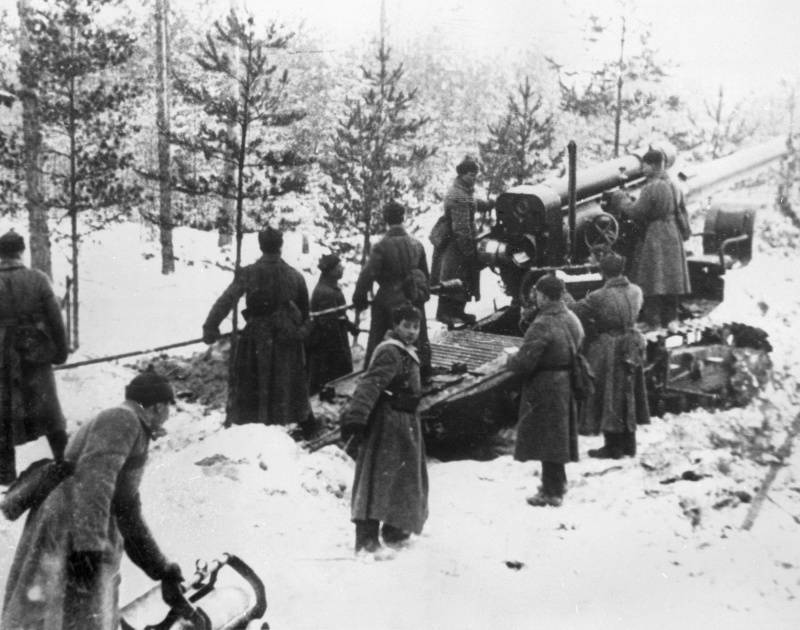
The calculation of the Soviet 203-mm howitzer B-4 shells Finnish fortifications
In the summer of 1938, comparative tests of two barrel wagons were carried out, according to the results of which both of these units were seriously criticized. Both B-29 and Br-10 did not meet the requirements. Soon, Plant No. 172 (Perm) was assigned the task of developing a new towed carriage for both the B-4 and the other two guns created at that time (the so-called artillery triplex). This masthead project, which received the designation M-50, did not receive due attention, due to which, by the beginning of World War II, the B-4 howitzers were still staffed with imperfect carriages and wagons.
The main element of the X-NUMX-mm high-power howitzer B-203 was a rifled barrel with a long 4 gauge (threaded part - 25 caliber). The guns of various series were produced with trunks of several types. These were bonded trunks without a liner, bonded with a liner and monoblock with a liner. According to reports, regardless of the design, the howitzers were interchangeable.
The barrel was locked using a Schneider system piston valve. The principle of the shutter depends on the type of trunk. So, guns with bonded trunks had a two- or three stroke valve. With monolithic trunks only push-pull valves were used. Recall the push-pull bolt rotates around its axis when unlocked with the barrel (first stroke), and then removed from the breech and simultaneously goes to the side, allowing you to charge the gun (second). In the case of the three-stroke scheme, the bolt first emerges from the barrel using a special frame (second stroke) and only after that it is set aside (third).
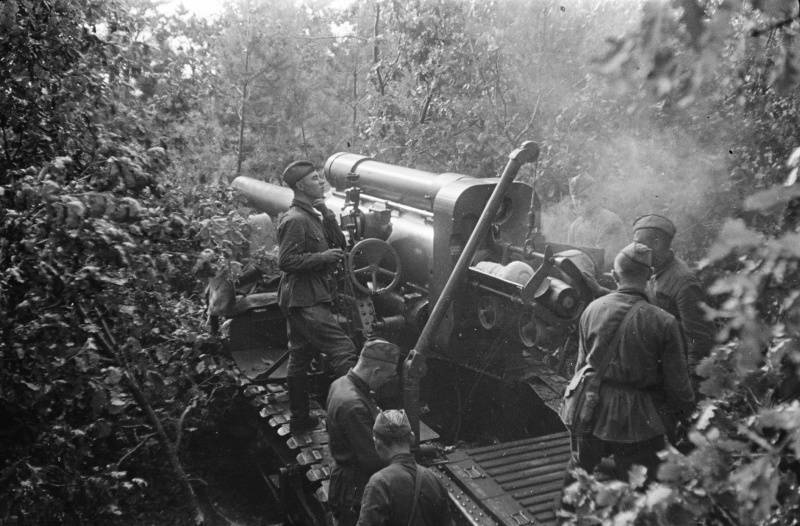
The calculation of the Soviet 203-mm howitzer B-4 firing on the outskirts of Voronezh. Howitzer barrel lowered to reload guns
The howitzer barrel was fixed on the recoil devices, made on the basis of the hydraulic brake recoil and hydropneumatic hatch. During the shot, all the recoil units were stationary. As an additional means of ensuring stability when shooting, a vomer mounted on the bed of a tracked gun carriage was used.
The cradle with the instrument was installed on the so-called. The top carriage is a structure that provides guidance in horizontal and vertical planes. The top carriage was in contact with the tracked chassis using a vertical warhead, which could be rotated using guidance mechanisms. The mast design and the limitations associated with the recoil power allowed horizontal targeting only within a sector of width 8 °. If necessary, transferring fire to a larger angle had to deploy the whole instrument.
The toothed sector of the lifting mechanism was attached to the cradle. With it, you can change the angle of elevation of the trunk in the range from 0 ° to 60 °. Negative angles of vertical pickup were not provided. As part of the lifting mechanism there was a system for quickly bringing the gun to the loading angle. With its help, the barrel automatically lowered and allowed to make loading.
All units of the towed howitzer B-4 were mounted on a crawler track of the original design. The gun was equipped with tracks 460 mm width, suspension system, brakes, etc. At the rear of the track, there was a bed with a coulter for pressing into the ground. Tracked gun carriage 203-mm howitzers arr. The 1931 of the year was later used as a base for other guns: the 152-mm cannon Br-2 and 280-mm mortars Br-5.
The new howitzer of high power was one of the largest and heaviest domestic artillery guns of the time. The assembled gun had a length of about 9,4 m and a width of almost 2,5 m. The height of the line of fire was 1910 mm. The length of the barrel with bolt exceeded 5,1 m, and their total weight reached 5200 kg. Taking into account the so-called. retractable parts of the barrel weighed 5,44 t. Lafet had a mass of 12,5 t. Thus, the ready-to-fire howitzer weighed 17,7 t, not counting the various aids and ammunition. The barrel carriage B-29 on caterpillar tracks had its own weight at the level of 7,7 t, the weight of the carriage with the barrel reached 13 t. The wheeled cart Br-10 weighed 5,4 t or 10,6 t with the trunk.
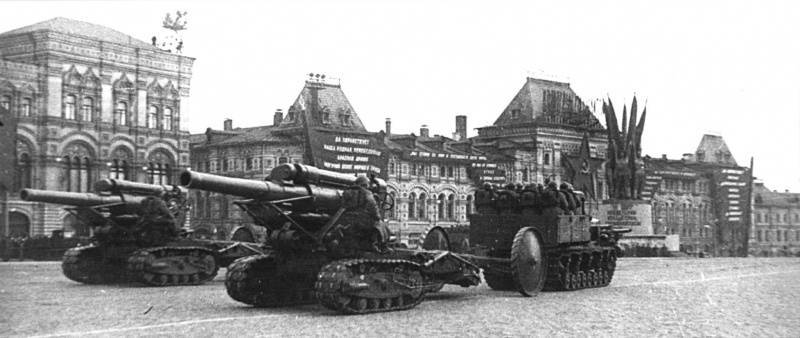
X-NUMX-mm howitzer B-203 towed by Komintern tractors across Red Square during the May Day 4 parade of the year. Howitzers B-1941 were part of howitzer artillery regiments of high power Reserve General Command
Howitzer B-4 serviced by the calculation of 15 people. They had a crane for loading shells and a number of other equipment that facilitated the operation of the gun. In particular, on the side surfaces of the carriage were two seats for gunners, covered with metal shields. The guidance control mechanisms were brought to both sides of the gun.
For long distances, the gun B-4 moved disassembled. The tracked carriage could be towed at a speed of no more than 15 km / h, the receiver carriage was no faster than 25 km / h. If it is necessary to move the howitzers for short distances (for example, between positions), towing is allowed when assembled. In this case, the speed should not exceed 8 km / h. Exceeding the recommended speeds threatened damage or destruction of the chassis.
The B-4 howitzer could use all the artillery shells of the 203 caliber mm available in service. Its main ammunition was the high-explosive shells of the F-625 and F-625D, as well as the concrete-breaking G-620 and G-620T. These munitions weighed about 100 kg and carried from 10 to 25 kg of explosive. In the post-war period, the range of ammunition for the B-4 gun was expanded with a special projectile with a nuclear warhead.
Cannon used split crank loading. Together with the projectile, it was proposed to place one of the 12 propellant variants in the chamber: from a total weight of 15 kg to No. 11 weighing 3,24 kg. The possibility of combining the weight of the powder charge and the angle of elevation of the barrel in combination with several types of projectiles with different characteristics provided greater flexibility in howitzer use. Depending on the type of target and the distance to it, it was possible to combine the angle of vertical guidance and the weight of the propellant charge. The muzzle velocity of shells ranged from 290 to 607 m / s. The maximum firing range achieved with the optimal combination of all variable parameters reached 18 km.
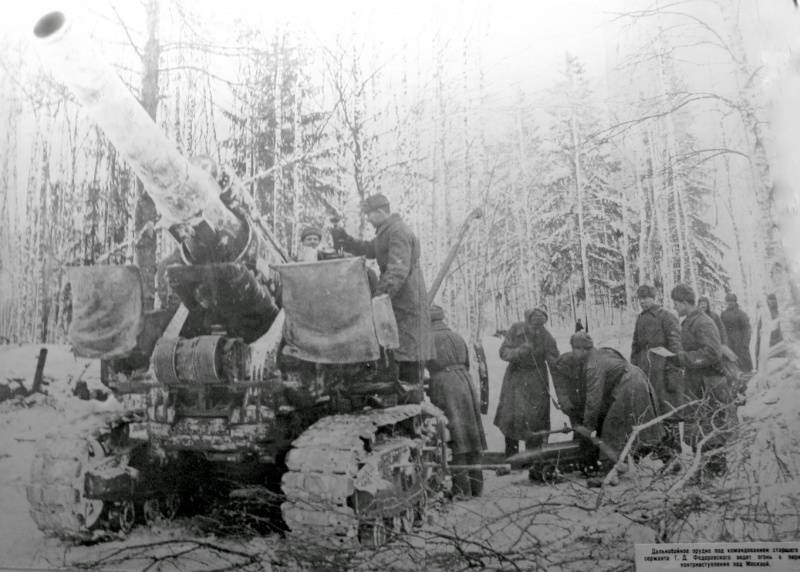
Long-range gun under the command of Senior Sergeant GD Fedorovsky is firing during the counteroffensive near Moscow - a caption under the photograph in the exposition of the Museum of Artillery, engineering troops and communications troops of the Russian Defense Ministry in the city of St. Petersburg
For loading shells and gunpowder cases, a small crane was used, located on the carriages' beds. Due to the large mass of ammunition, manual loading was difficult. Before climbing to the line of loading, the shells were placed in a special tray, which was lifted by a crane. Such equipment facilitated the calculation work, but the rate of fire was small. A trained calculation could do one shot in two minutes.
Despite all the difficulties, three factories for several years were able to master the production of high-power howitzers B-4 arr. 1931. At the peak of production, each of the three plants annually produced several dozen guns. By the beginning of World War II, the Red Army had 849 with such howitzers, which exceeded the initially required number.
It is known that in August 1939, a new mobilization plan was approved, which, among other things, established the organizational structure of high-powered artillery. As part of the Artillery Reserve, the High Command planned to form 17 howitzer artillery regiments of high power (gap b / m) with 36 B-4 howitzers in each. The strength of each regiment is 1374 man. 13 new regiments had to have a dual deployment. The troops needed a total of 612 new guns. At the same time, to meet the requirements of wartime, it was necessary to additionally build an order of howitzer 550-600.
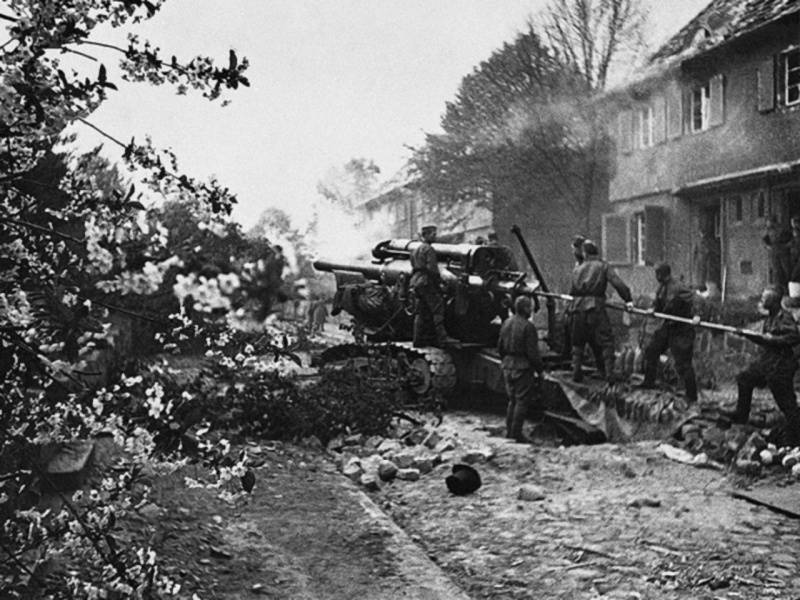
Howitzer B-4, attached to the 1 rifle battalion of the 756 rifle regiment of the 150 rifle division of the 79 rifle corps of the 3 th shock army of the 1 Belorussian Front, during the Berlin offensive operation. The commander of the battalion is captain S. Neustroyev, the future Hero of the Soviet Union
The first armed conflict in which B-4 howitzers were used was the Soviet-Finnish war. By the end of 1939, almost one and a half hundred of such guns were deployed to the front, which were actively used to destroy the Finnish fortifications. B-4 guns proved to be ambiguous. The power of the howitzer was enough to destroy some of the pillboxes, but often the gunners had to deal with more secure targets. Sometimes for the destruction of a concrete structure it was required to hit a single point with two or three projectiles. At the same time, in order to conduct effective fire, the howitzer had almost to be manually brought over a distance of about 200 m from the target. The overall mobility of the howitzer also left much to be desired due to restrictions associated with its transportation.
The combat work of the artillerymen was complicated by small angles of horizontal guidance, which made it necessary to deploy the whole weapon in order to transfer fire to a large angle. In some situations, the calculations did not have enough protection from enemy fire, which is why they had to rely on hastily dug trenches and other shelters.
Nevertheless, despite all the problems and difficulties, the B-4 high-power howitzers coped well with their duties. The use of these guns allowed the destruction of a large number of Finnish fortifications and thus allowed the troops to complete the assigned tasks. Of the 140 over-the-counter howitzer 1939-40 in the winter, only 4 was damaged or lost. The rest at the end of the war returned to the unit. Successful hit concrete-shells left from the Finnish fortifications a pile of crushed concrete and bent reinforcement. For this, the B-4 howitzer has received the nickname “Karelian sculptor”.
22 June 1941, the composition of the Artillery of the Reserve of the High Command had 33 gap b / m armed with B-4 howitzers. Statewide, they were supposed to have 792 howitzers, although their actual number, according to some sources, did not exceed 720. The outbreak of war led to the loss of a certain number of guns. Over the summer and autumn of 41, the Red Army lost 75 howitzers for various reasons. The production of such weapons was greatly reduced in favor of more relevant systems, because of which during the war only 105 howitzers were manufactured and transferred to the troops.
Part of the lost guns became trophies of the German troops. So, the 529 th gap b / m, not having the necessary number of towing vehicles, in the summer of the 41 th lost 27 serviceable guns. In the Wehrmacht, the captured B-4 received the designation 20,3, see Haubitze 503 (r) and was limitedly used during various operations. For shooting from these howitzers, the Germans used the captured concrete shells of the G-620 and powder guns of their own production. For several reasons, the number of "German" B-4 is constantly declining. So, by the spring of 44, the enemy had only 8 captured guns.
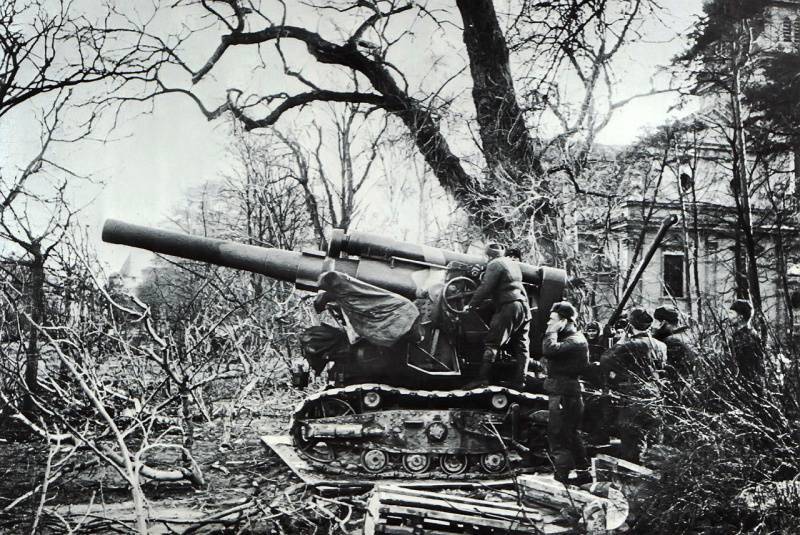
The calculation of the Soviet 203-mm howitzer B-4 under the command of Senior Sergeant S. Spin in the Sopot suburb of Danzig (now Gdansk, Poland) is firing at the German troops in Danzig. On the right is the Savior’s Church (Kościół Zbawiciela)
In view of the low mobility and the constant retreat of the troops, the Red Army command decided in the summer of 1941 to withdraw all the howitzer artillery regiments of high power to the rear. The gunners returned to the front only towards the end of 1942, when the strategic initiative began to move to the Soviet Union. Subsequently, B-4 howitzers were actively used in various offensive operations as a means of destroying enemy fortifications.
Like other howitzers, gun arr. The 1931 of the Year was intended for firing on hinged paths. However, in the second half of the war, the Red Army soldiers mastered direct fire. The first such incident occurred 9 June 1944 of the year on the Leningrad front. The task of the artillery of high power was the destruction of a well-defended large pillbox covered with other firing points. This complex of fortifications was the basis of the enemy’s defense in the area, which required it to be destroyed as soon as possible. Red Army artillerymen under the command of the battery commander of the guard captain I.I. Vedmedenko, masking the tractor with the noise of battle, brought two B-4 howitzers to the position. For two hours, howitzers of direct fire from a distance of 1200 were beaten with concrete shells along walls of a few meters thick fortifications. Despite the non-standard method of application, the tools coped with the task. The commander of the battery, which destroyed the pillbox, was awarded the title Hero of the Soviet Union.
Further 203-mm howitzers high power arr. 1931 was repeatedly fired direct fire. Widely known newsreel footage, on which the calculation of the gun shoots in this way on the streets of Berlin. However, the main method of shooting remained fire "in a howitzer", with large elevation angles. At the time of the end of World War II, the troops had 760 such howitzers.
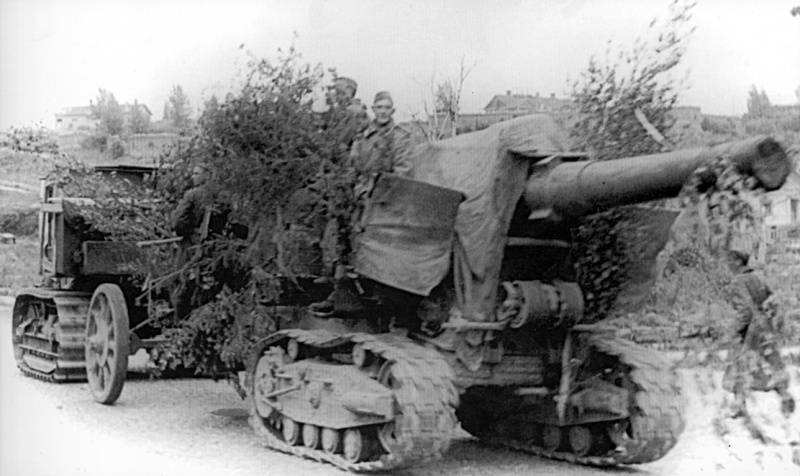
A characteristic feature of the B-4 howitzer was its low mobility, due to the limitations of the tracked carriage used. The solution to this problem could be the creation of a self-propelled artillery installation armed with such a gun. In the thirties, Soviet engineers developed self-propelled guns SU-14 based on heavy tank T-35. The maximum speed of such a car on the highway reached 22 km / h. Two prototypes were built, which in 1940 were tested and sent for storage. In the 41st they were sent to the Kubinka station to participate in the defense of Moscow. This was the only combat use of such self-propelled guns.
After the end of the war, the military returned to the idea of creating a wheeled carriage for B-4 and other guns. For a number of reasons, the work was delayed, with the result that the prototype B-4М howitzer appeared on a wheel drive only in the 1954 year. The new wheeled carriage to some extent repeated the design of the tracked. Howitzer attachment systems remained the same, the upper carriage also did not undergo major changes. The lower carriage aggregates received a base plate and four wheels. In preparation for shooting the wheels had to rise, with the result that the support plate of the gun fell to the ground.
In 1954, the military tested a new carriage with a B-4 gun and a 152-mm cannon Br-2. The following year, it was adopted. New units were equipped with B-4 guns (after such an upgrade they were designated as B-4М), Br-2 and Br-5. New trunks, bolts, etc. not produced. The upgrade was to install the existing units on the new carriages.
Having more power and high power shells, howitzer arr. 1931 remained in service until the end of the eighties. Moreover, in the mid-sixties, the range of its ammunition was supplemented with a new special projectile 3BB2 with a nuclear warhead. Such ammunition allowed to significantly increase the combat capabilities of the old gun.
The high-power howitzer B-4 caliber 203 mm is one of the most famous artillery guns of the USSR during the Great Patriotic War. A weapon with a characteristic design and high performance has become one of the symbols of any offensive operation of the Red Army. All major operations carried out since the end of 1942, were carried out with the fire support of 203-mm howitzers, confidently striking the fortifications of the enemy.
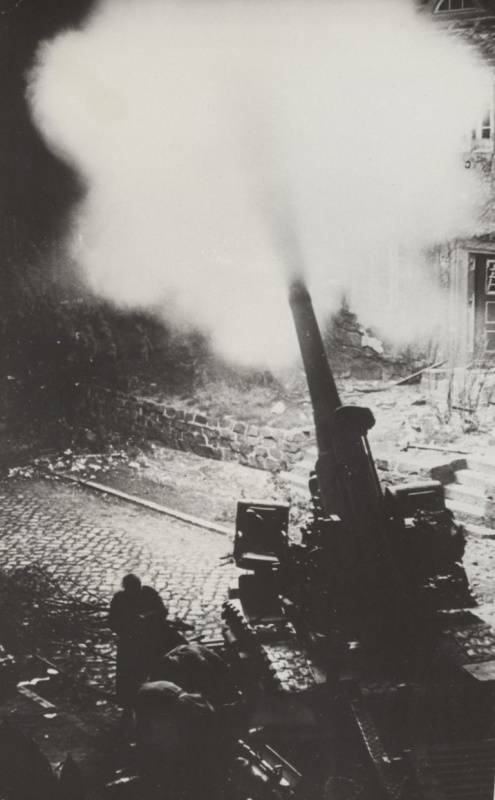
Soviet 203-mm howitzer B-4 firing in Berlin at night
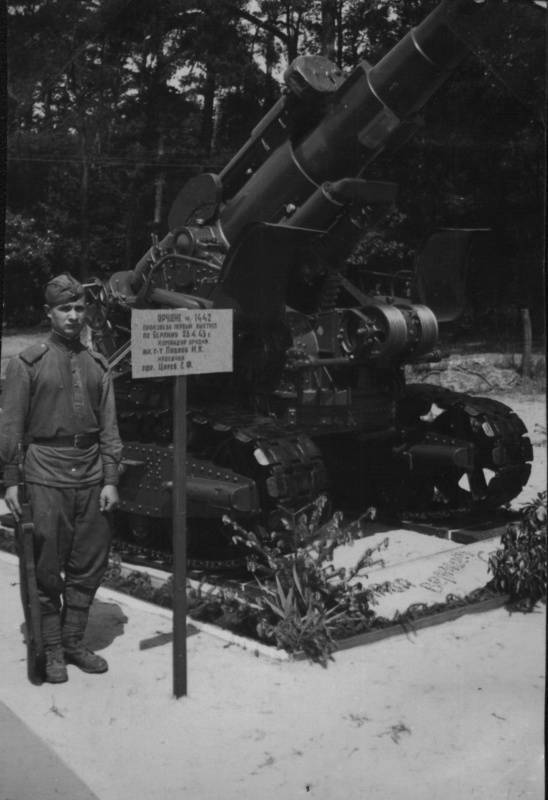
A Soviet soldier at the 203-mm howitzer B-4 of model 1931 of the 9-th howitzer artillery brigade.
The inscription on the plate: "Tool number XXUMX. Made the first shot at Berlin 1442. Gun Commander - ml. S. Pavlov I.K. Gunner - Eph. Tsarev GF "
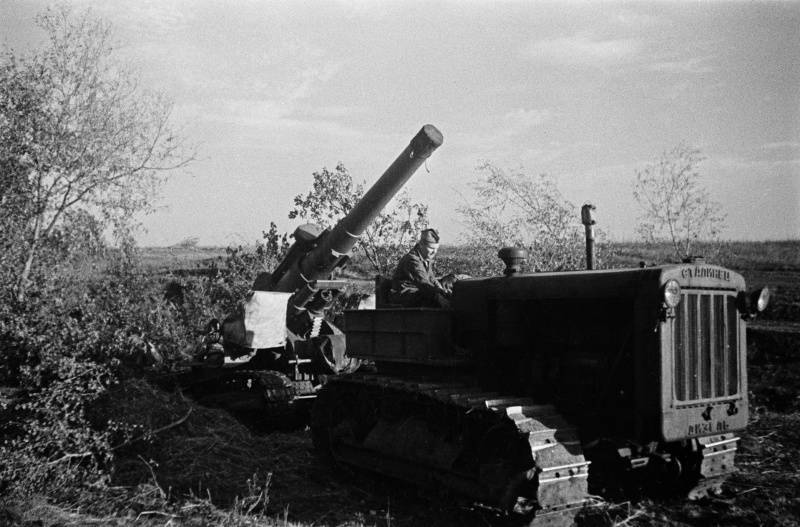
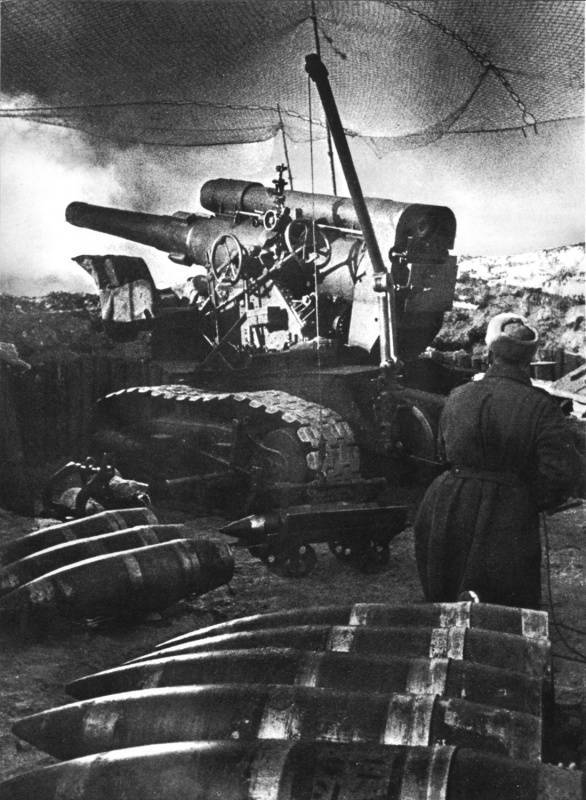
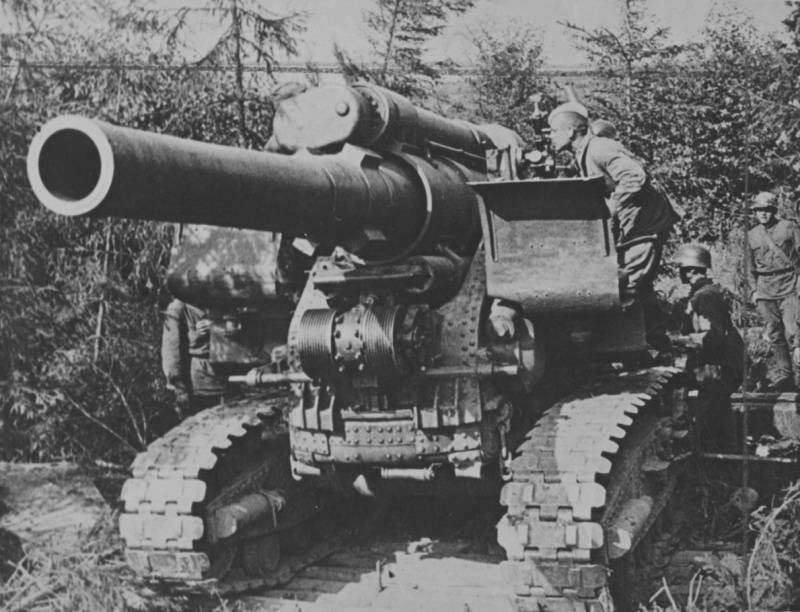
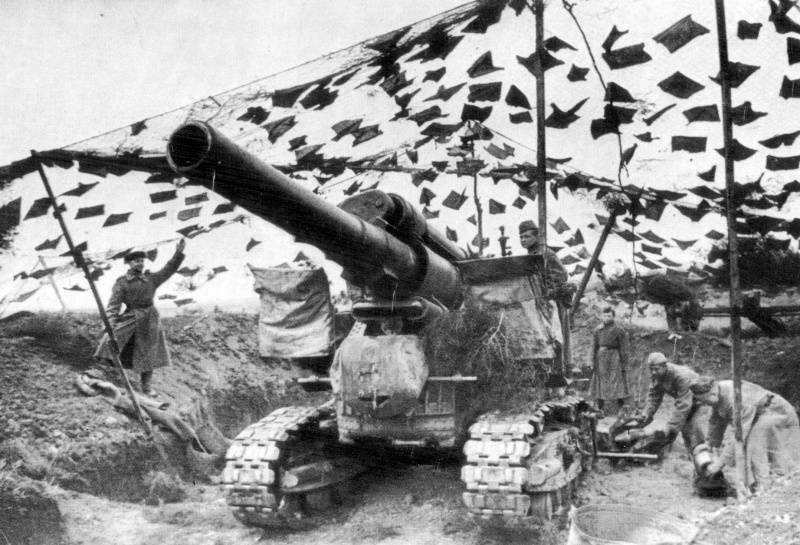
On the materials of the sites:
http://las-arms.ru/
http://prowars.ru/
http://armor.kiev.ua/
http://vpk-news.ru/
http://technicamolodezhi.ru/
http://gorod.tomsk.ru/
Information